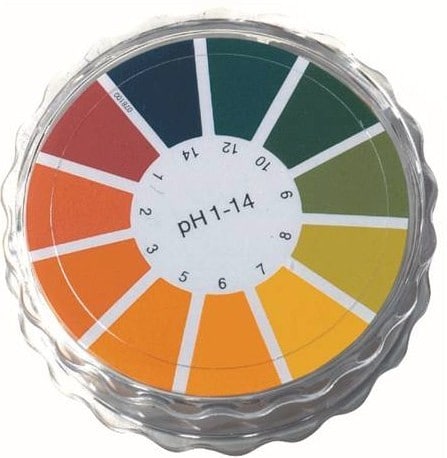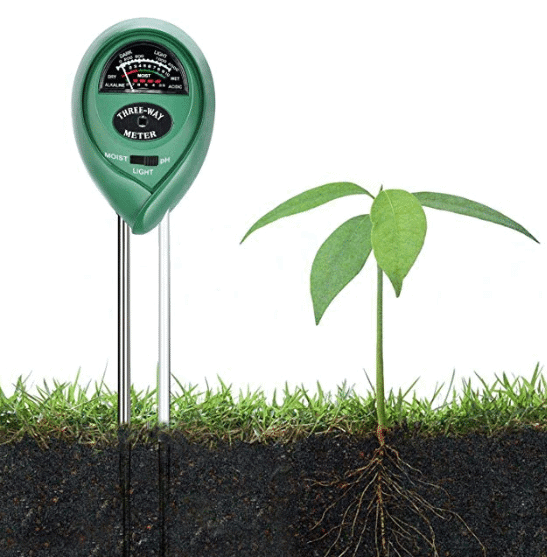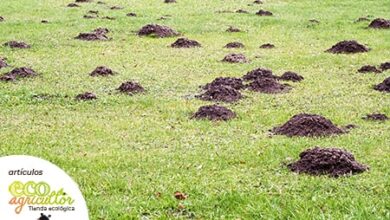What is and How to Measure the pH of the Earth?

Knowing the pH provides us with information very important about cultivation.
For example, most of the nutrients a plant needs to grow stable are in a neutral pH range.
However, the pH required in a garden depends on the type of plants , but in general it is not recommended to keep values lower than 4 and higher than 9.
What is the pH of the soil?
 The pH scale It is divided into 14 values, with a value of 0 to 7 being acidic and from 7 to 14 an alkaline substance. The neutral value of this range is 7.
The pH scale It is divided into 14 values, with a value of 0 to 7 being acidic and from 7 to 14 an alkaline substance. The neutral value of this range is 7.
When the pH values are 7.5 there may be problems with the availability of iron . This lack is reflected in the leaves , especially the younger ones.
They usually have yellowish spots that start at the top of the plant and cover the entire leaf . Likewise, growth is delayed and the leaves can get burned.
If the pH is very basic , the possible absorption of phosphorus and, in general, of most of the micronutrients, is blocked .
The approximate pH of the different crops
Here we leave a list to know the pH that the soil of our garden should have depending on the fruits and vegetables that we want to plant.
- Broccoli : 6.0-7.4
- Onion : 6.0-7.3
- Cauliflower : 6.0-7.3
- Pepper : 6.3-7.9
- Tomato : 5.7-7.3
- Carrot : 5.7-7.2
- Lettuces : 5.8-7.3
- Strawberries : 5.0-6.3
- Eggplant : 5.5-6.2
- Radish : 6.2-7.5
- Cucumber : 5.6-7.1
- Corn : 5.5-6.7
- Peas : 5.9-7.2
- Spinach : 6.2-7.3
- Chard : 6.0-7.4
- Potato : 5.0-5.8
- Rice : 5.1-6.6
- Lentil : 5.1-7.2
What happens if there is a lack of phosphorus?
Phosphorus deficiency can be identified early on because the leaves turn yellow around them .
If the problem persists, the leaves will die and come off starting at the bottom . Likewise, it will not develop properly and the root system will be very poor.
On the other hand, if the values are below 5.7 the soil may present little microbiotic activity.
This is very important because it is found in organic matter and helps to maintain the structure of the soil, as well as to retain the necessary water without becoming waterlogged and acts as a nutrient reserve for plants.
What does a very acidic pH imply?
If the pH is very acidic will be deficient in bases such as calcium, potassium, and magnesium .
The activity of microorganisms is also reduced , as well as phosphorus.
Micronutrients, except molybdenum , are better absorbed in this type of soil, but they are not recommended due to the deficiency of the other nutrients.
Potassium deficiency is related to yellow leaves on the margins and later brown in color. At this point the leaves contract and die.
Later, spots appear on the stems and the leaves of the lower level do not grow. Potassium deficiency is a serious problem as it increases the chances that the plant will contract diseases and pests .
What happens if there is a lack of magnesium?
Lack of magnesium It can be identified because while the veins remain green, the center of the plant turns yellowish .
The lower leaves are wrinkled and if it has been a while the problem spreads to the other leaves of the plant.
The leaves also show very little growth and if several days have passed it may suddenly show dead zones . Also, flowering stops or they lack good coloration.
What about a lack of calcium?
The lack of calcium is identified when the ends of the leaves and the upper part of the plant die . There is also suffering from the roots, almost all of them dying like this.
In general, the plant is very dull.
How is soil pH measured?
There are some ways to measure soil pH.
To know more : How to change the pH of the soil?
We will explain two that can be the most accessible:
- The least complicated is to measure with a pH meter . This is a device which measures the pH range of aqueous solutions . Therefore, you have to take a sample of the soil (not from the surface part).
- Afterwards, you must remove the leaves and twigs . You dilute it with a little water and then proceed to measure with the artifact.
- In about 60 seconds it will release the pH value of the solution.
- Make sure that before introducing the pH meter into the mud it is clean to avoid errors in the measurement.
- The second way is with pH measuring strips.
- These can be found at a pharmacy or chemical store .
- Likewise, collect a small sample of soil and stir it well with water until it is completely dissolved . Subsequently dip a plaster for approximately 40 seconds.
- Remove it and let it dry . Finally, compare the coloring with the diagram that comes in the package.

How to raise the pH of the soil?
If the pH is low you need to add a base.
The most common is lime . You can find it in household products . It is preferable that it is sprayed to be able to spread throughout the pot and that the soil can absorb it easily.
Ash from burned plants or trees is also a viable option for increasing pH levels .
Take care not to add too much since in the future you could have problems with the alkalinity of the soil . Be careful not to put it near the roots and shoots.
How to lower the pH of the soil?
 To lower the pH of the soil, it is recommended that you add aluminum sulfate for immediate effects, however, try to use it in moderation since the acidity level in the soil can skyrocket .
To lower the pH of the soil, it is recommended that you add aluminum sulfate for immediate effects, however, try to use it in moderation since the acidity level in the soil can skyrocket .
Another method that takes several months but is also effective is adding sulfur and organic matter.
What is the pH of a sandy soil?
Normally these soils present the extremes of the pH range depending on the climate, humidity and nutrients present . Therefore, it is recommended to add organic matter or nutrient solutions.
What is the pH of a clay soil?
Normally they present values above 7 , in order to facilitate the cultivation in them it is recommended to add some substrate .
What is the pH of an acidic soil?
An acid range is considered from 0 to 7 . Most plants find it difficult to subsist at values lower than 6.5.

![Photo of Bonsai: [Characteristics, Utility, Types, Meaning and Purchase]](https://www.complete-gardening.com/wp-content/uploads/2022/08/bonsai-characteristics-utility-types-meaning-and-purchase-390x220.jpg)


![Photo of Chamaecyparis Lawsoniana: [Cultivation, Care, Pests and Diseases]](https://www.complete-gardening.com/wp-content/uploads/2022/08/chamaecyparis-lawsoniana-cultivation-care-pests-and-diseases-390x220.jpg)